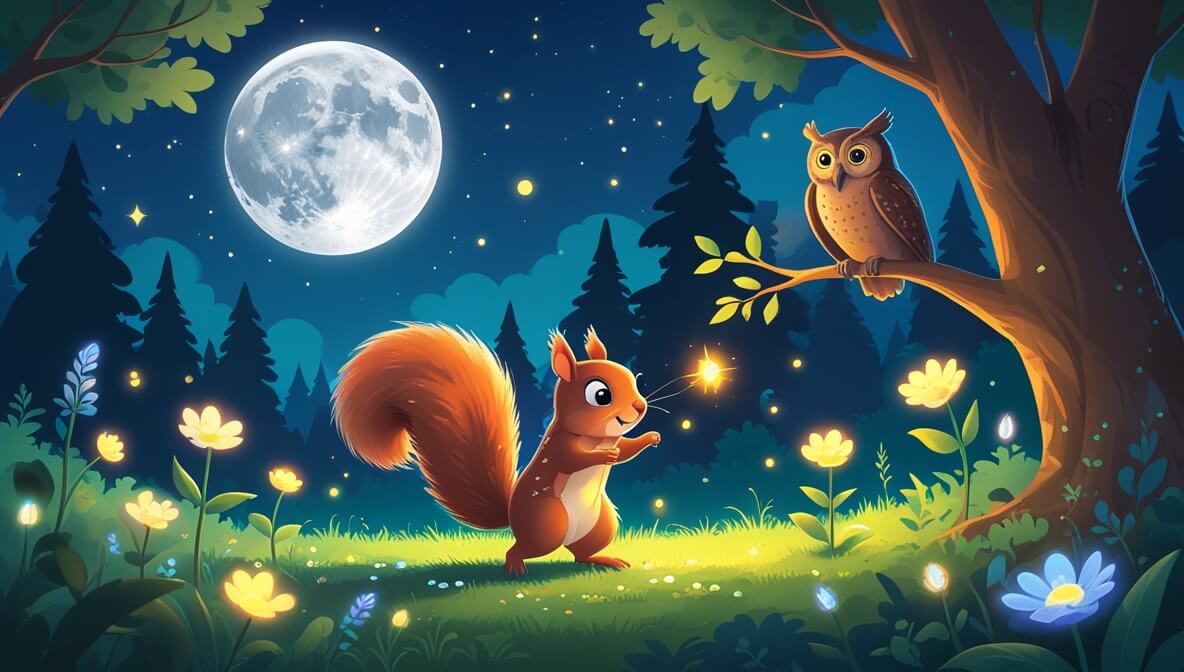Little Seren the squirrel discovers a magical patch of moonflowers that glow at night, leading to a nighttime adventure and new friendships under the stars.
Age Recommendation
0 – 4 years
Characters
Characters:
- Seren (a curious little squirrel with a fluffy tail)
- Twinkle (a friendly firefly with a bright glow)
- Whisper (a wise old owl who knows many stories)
Story
Seren the squirrel lived in a big, green forest. One night, Seren saw something glowing under the trees. It was a patch of magical moonflowers. As the moonlight kissed the petals, they began to shine brightly, lighting up the forest path.
The Moonlit Discovery
Seren was amazed. “What are these wonderful flowers?” he wondered. Just then, a little firefly named Twinkle fluttered by. “Hello, Seren!” chirped Twinkle with a warm glow. “These are moonflowers. They only bloom and glow at night.”
Friends Under the Stars
Seren and Twinkle decided to explore. They giggled as they danced among the glowing flowers. “Let’s find someone to share this magic with,” said Seren. They flapped and fluttered until they reached Whisper, the wise old owl perched on a branch.
Stories and Sparkles
“Oh, what a lovely sight,” said Whisper, his eyes twinkling like stars. “These flowers hold a secret. When they bloom, they tell stories of the moon.” Seren and Twinkle listened as Whisper shared tales of the moon’s journey across the sky. The forest felt peaceful and full of wonder.
As the night went on, Seren realized he had made new friends and discovered a new world. Together, they watched the moonflowers glow until they slowly closed with the coming dawn.
The end.
Moral of the Story
The story teaches us the importance of curiosity, friendship, and the magic of nighttime adventures.
Questions to Think About
- What do you think moonflowers look like?
- Why is it fun to have adventures at night?
- How did Seren feel when he found the moonflowers?
- Who would you explore the forest with?
- What stories would you like to hear from Whisper?
Do You Know
- Fireflies produce light through a chemical reaction in their bodies, called bioluminescence.
- Owls can rotate their heads almost all the way around!
Word Explorer
- Moonflowers: Special flowers that glow at night.
- Curious: Wanting to know more about something.
- Bioluminescence: Light made by living things, like fireflies.
Emotions in the Story
- Curiosity: When Seren saw the glowing moonflowers and wanted to learn more.
- Joy: When Seren and Twinkle danced among the moonflowers.
- Wonder: As Whisper told stories of the moon and stars.
Color Your Scene
Imagine Seren and Twinkle dancing under the glowing moonflowers. Can you draw them with the moonlight shining, making everything look magical? Use bright yellows and soft blues to show the glowing flowers and the nighttime sky.
Parents’ Corner
This story is a great way to talk to your child about:
Curiosity: Encourage your child to ask questions and explore the world around them, fostering a love for learning.
Friendship: Discuss how Seren and Twinkle’s adventure was more fun because they shared it together.
The magic of nighttime: Highlight how beautiful and peaceful the world can be at night, inspiring a sense of wonder and calm.











